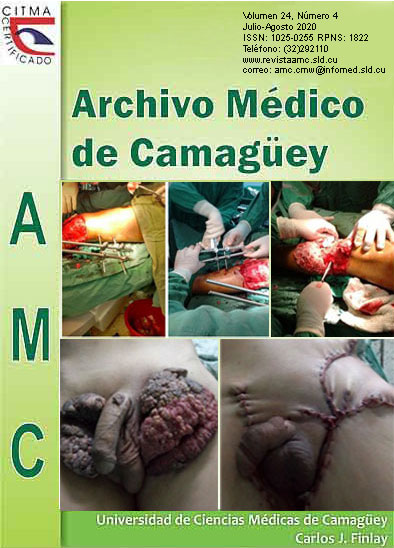Biofilm and antimicrobial resistance
Downloads
References
1. Lasa Uzcudun I. Biofilms bacterianos [Internet]. Instituto de Agrobiotecnología y Recursos Naturales y Departamento de Producción Agraria: Universidad Pública de Navarra; 2004 [citado 18 Oct 2019]. Disponible en: http://crinoidea.semicrobiologia.org/pdf/actualidad/SEM37_14.pdf
2. Olmeda Pérez R. Nanovehículos para el tratamiento de la infección bacteriana [tesis]. Madrid: Universidad Complutense de Madrid, Facultad de Farmacia; 2017 [citado 18 Oct 2019]. Disponible en: http://147.96.70.122/Web/TFG/TFG/Memoria/RAQUEL%20OLMEDA%20PEREZ.pdf
3. Alonso Fernández B. Bacteriemia relacionada con el catéter y neumonía asociada a ventilación mecánica: nuevas estrategias de erradicación del biofilm [tesis]. Madrid: Universidad Complutense de Madrid, Facultad de Medicina; 2019 [citado 18 Oct 2019]. Disponible en: https://eprints.ucm.es/56658/1/T41279.pdf
4. Sandoval M, Saade D, Romero A, Rodríguez K, Sánchez C, Salinas K, et al. Nontypeable Haemophilus influenzae: mechanism of biofilm destruction. Rev ANACEM [Internet]. 2018 [citado 18 Oct 2019];12(1):[aprox. 8 p.]. Disponible en: https://issuu.com/revistaanacem/docs/revista_anacem_12_1_1_
5. Patiño Bello D, Pérez Acevedo L, Torres Caicedo M. Uso de biocidas y mecanismos de respuesta bacteriana. Rev Cubana Inv Biom [Internet]. 2018 [citado 18 Oct 2019];37(3):[aprox. 17 p.]. Disponible en: http://scielo.sld.cu/pdf/ibi/v37n3/ibi14318.pdf
6. Bustos CP, Marfil MJ, Lanza NS, Guida N. Estudio de la capacidad productora de biofilm en Streptococcusequisubsp.equi. Rev Vet [Internet]. 2017 [citado 18 Oct 2019];28(3):[aprox. 6 p.]. Disponible en: https://revistas.unne.edu.ar/index.php/vet/article/view/1289
7. Moreno Y, Moreno Mesonero L, Soriano Ponce A, Macián Cervera VJ. Estudio de las poblaciones bacterianas en biofilms de sistemas de distribución de agua potable mediante metagenómica. Rev Tecnoaqua [Internet]. 2019 [citado 18 Oct 2019];(37):[aprox. 7 p.]. Disponible en: https://www.researchgate.net/profile/Yolanda_Moreno/publication/334225061_Articulo_Tecnico/links/5d1daaf0458515c11c0f9bb9/Articulo-Tecnico.pdf
8. Deng B, Ghatak S, Sarkar S, Wozniak DJ, McComb DW, Sen CK, et al. Novel Bacterial Diversity and Fragmented e DNA Identified in Hyperbiofilm-Forming Pseudomonas aeruginosa Rugose Small Colony Variant. Sience [Internet]. 2020 [citado 18 Feb 2020];23(2):[aprox. 23 p.]. Disponible en: https://www.ncbi.nlm.nih.gov/pmc/articles/PMC6997594/.
9. Hu Q, Tan L, Gu S, Xiao Y, Xiong X, Wei-ai Z, et al. Network analysis infers the wilt pathogen invasion associated with non-detrimental bacteria. NPJ Biofilms Microbiomes [Internet]. 2020 [citado 18 Feb 2020];6(1):[aprox. 8 p.]. Disponible en: https://www.nature.com/articles/s41522-020-0117-2
Published
How to Cite
Issue
Section
License
Copyright: Camagüey Medical Archive Magazine, offers immediately after being indexed in the SciELO Project; Open access to the full text of the articles under the principle of making available and free the research to promote the exchange of global knowledge and contribute to a greater extension, publication, evaluation and extensive use of the articles that can be used without purpose As long as reference is made to the primary source.
Conflicts of interest: authors must declare in a mandatory manner the presence or not of conflicts of interest in relation to the investigation presented.
(Download Statement of potential conflicts of interest)
The Revista Archivo Médico de Camagüey is under a License Creative Commons Attribution-Noncommercial-No Derivative Works 4.0 International (CC BY 4.0).
This license allows others to distribute, to mix, to adjust and to build from its work, even for commercial purposes, as long as it is recognized the authorship of the original creation. This is the most helpful license offered. Recommended for maximum dissemination and use of licensed materials. The full license can be found at: https://creativecommons.org/licenses/













 22 julio 2025
22 julio 2025